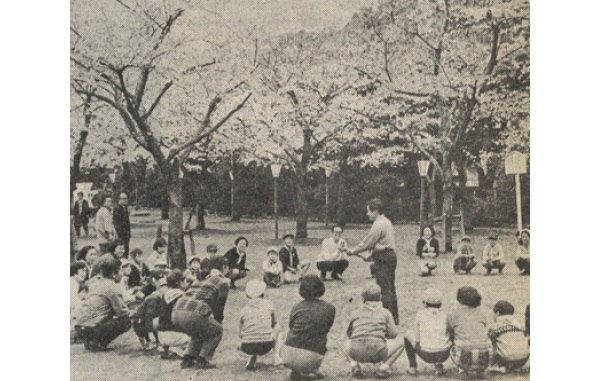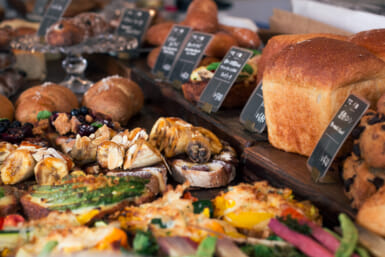Cherry Blossom Viewing in Ueno Park
by Rick Kennedy
Winter does not ravage Tokyo, but as the city disdains central heating it must still keep warm by huddling close to kerosene heaters, burrowing under kotatsu and quitting warm and companionable offices at the last possible moment. By December, it is dark at breakfast time and dark again by the time the afternoon papers hit the kiosks. A January, a Scandinavian sort of gloom has descended.
Then in mid-February come the first signs of impending release. A shopping street decorates its telephone poles with sprays of plastic flowers, idiot color against a gray city. Subway posters begin to advertise banquet halls for spring weddings by depicting smiling beauties in kimono against a panoply of cherry blossoms. The blossoms seem unreal, a figment of the advertising imagination, but they strike a chord. People loosen their scarves and crack open the window on the train a cautious centimeter.
Sometime in mid-March comes the news that the sakura is blooming in Kyushu. Every night from then on the TV news flashes a map delineating the advancing front. The newspapers take up the theme—in Tokyo the blossoms are sanbu zaki (30 percent open), then gobu zaki (50 percent open), then shichibu zaki (70 percent). Give or take a few days, the blossoms in Tokyo should be mankai, in full bloom, sometimes in the first week of April.
The city begins to organize for a series of flower-viewing parties called ohanami, a pagan celebration of a one-a-year explosion of nature which is all the more glorious because it is so fleeting, (The blossoms are at their peak for three days at most.) The blossoming of the cherry is the natural beginning of the Japanese year. It is when the schools and universities begin the new academic year. It is when the new employees join their new companies. It is when everything begins again.
Ueno Park is the most famous place in Japan to view the blossoming cherry. Not the loveliest, not the most horti-culturally remarkable, nor the most evocative, and certainly not the most tranquil—just the most famous. To attend hanami in Ueno is to watch Tokyo celebrating its Japaneseness. It is like America at a ball game, Spain at a bullfight, youth at a rock festival. The feeling is: this is who we are—Viewers of Blossoms! Drinkers of Sake! Zingers of Zongs! We are all out of our minds! Yaaaao!
One each of the days the trees are in bloom, a quarter of a million people might wander through Ueno Park. The park is one of Tokyo’s largest, accommodating a couple national museums, a zoo and a concert hall but, as everyone congregates under the trees in one small section of the park, the scene is Woodstockian. People wander, looking for their party among hundreds of parties, which after a time blur into one great party.
Local companies have strung hundreds of red lanterns with their names conspicuously inscribed to illuminate the trees. There are parties of tens and twenties, interspersed with larger groups of forty or more. They sprawl (men) or sit primly (women) on flattened cardboard cartons around stacked cases of beer and barrels of sake, their territory delimited by a border of shoes. They feast on platters of sushi, ears of roast corn, skewers of yakitori, bananas, pizza, cotton candy, cucumber sandwiches. Champagne, noodles.
There is rhythmic clapping to wobbly singing. Latin music, German folksongs, Russian revolutionary ballads, enka, chansons, teenage lullabys and the thunder of ancient drums. Someone starts singing through a bullhorn, his voice cracking. Applause breaks out here, then over there. Flashes of strobe lights, like summer lightning, as people take pictures. One group has lugged in a full-fledged sound system, but even they make no dent in the din.
A large group raises plastic cups in unison to a “Kampai!” Someone in a smaller, very cohesive group leads an elaborate, well-rehearsed cheer. A salaryman in vested suit and striped tic does a wild barefoot dance, then collapses giggling. He is cheered by his group, all business colleagues. An isshobin (two-quart bottle) of sake is passed down the line. It gurgles as it is upended. Someone sings solemnly from a song-book.
Lovers stroll people-watching, feeding each other yakitori. A photographer waltzes with his tripod, a man in love with his art. A fanatic sits sipping sake and watching the ballgame on a full-sized television set.
It is a genial crowd. The police are headquartered in a great white tent. The chief of the division, gold braid on h sleeve, oversees the carnival, like a benevolent daimyo. The sweet voice of a policewoman is super-amplified over the hubbub: “Be wary of anyone in your group you don’t know. Watch out for your handbags and wallets.” A bum in his winter regalia of a long tattered topcoat and yachting cap beams a wispy smile at the foreign lady tourist. “I love you,” he says. A wandering minstrel in baggy trousers offers to entertain with his shamisen, but there are no takers.
Aged great-grandmothers on the arm of an indulgent relative are brought to see the spectacle. Children come and are indulged with balloons, lollipops, goldfish and battery-driven pandas. A space is cleared and three mouth organs and a castanet give out with songs of the ’30s. Several couples foxtrot on a ballroom floor of flattened cartons and spectators sing along sotto voce. A scene from an old movie.
Toward the end of the evening the petals begin to flutter down. It is the beginning of the end for the year. Tomorrow if there is a breeze we will see hanafubuki, a storm of flower petals, and the pavement will turn white as with snow.









